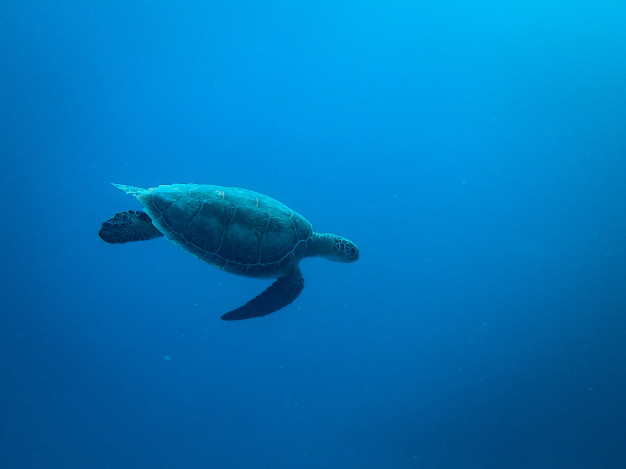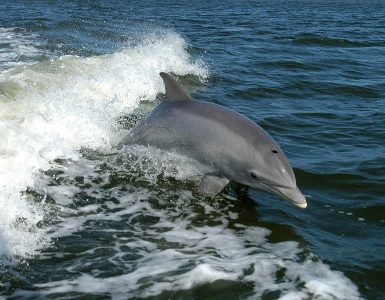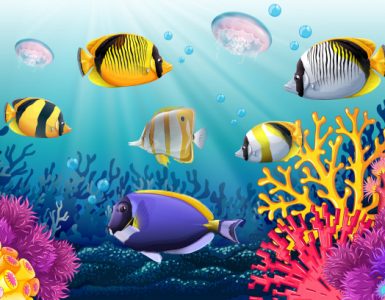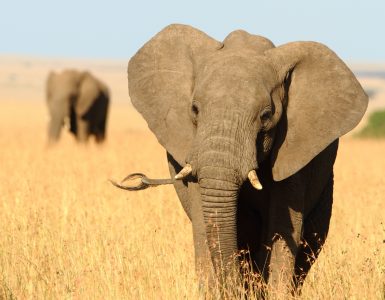
Image courtesy: Pixabay
Sea turtles are marine reptiles that have adapted secondarily for aquatic or semi-aquatic lifestyles under marine conditions. The extant marine reptiles include; sea snakes, sea turtles, marine iguanas and saltwater crocodiles. The origin of turtles spans back to Late Permian Epoch. Seven species of sea turtles have been recorded so far. Leatherback, Loggerhead, Kemp’s ridley, Green, Olive ridley, and Hawksbill are commonly encountered in every ocean except the Arctic and Antarctic. The Flatback, the seventh sea turtle, lives only in the waters around Australia. The Leatherback turtle is the largest and Kemp’s ridley is the smallest of all.

Image courtesy – https://ocean.si.edu/home
Sea turtles are considered as excellent swimmers and divers. Forelimb modification into long, paddlelike flippers for swimming, flat and streamline shell, high concentration of red blood cells (erythrocytes) and myoglobin for oxygen transportation and storage, high lung capacity compared to their kins on land and excess salt secretion have made them adapted for marine life extremely well.
Even at diminished population levels sea turtles play important roles for the well-being of the marine ecosystem. They help to maintain healthy seagrass beds and coral reefs, provide key habitat for other marine life, help to balance marine food webs and facilitate nutrient cycling from water to land.
Herbivorous sea turtles such as Green turtles eat seagrass and help to maintain healthy seagrass beds. Constant grazing is needed as seagrasses tend to overgrow and obstruct currents, shade the bottom, begin to decompose and finally leading to the growth of slime moulds which is detrimental to the health of the marine habitat. Healthy seagrass benefits many species including Dugongs and stores carbon.
Turtles are important for species composition and distribution in coral reefs. Hawksbill sea turtles possess beak-like mouths and forage on marine sponges. This manipulates the composition and distribution of sponges in coral reef ecosystems. Sponges compete for space with reef-building corals vigorously and by removing sponges from reefs, hawksbills allow corals, to colonize and grow. The decline of Hawksbills causes the overgrowth of sponges among the reef communities, limiting the growth of corals and ultimately modifying the very structure of coral reef ecosystems. This might lead to the decline of coral dwelling fish species including commercially exploited reef fish which in turn decrease a food source for people. Most fish species and marine mammals are unable to forage on sponges as they possess severe defensive properties chemically and structurally. Sponges have spicules that provide structural support as well as deter predators and they also defend themselves by producing chemically active compounds such as ageliferin. Selective foraging behaviour of Hawksbills has a greater impact on the overall diversity of reef communities.
When the female sea turtle lay their eggs on sandy beaches it directly and indirectly affect the vegetation, species distribution and stability of sandy shorelines. Eggs have four possible fates that are in accordance with energy flow in the ecosystem: 1) the eggs hatch and most of the nutrients return to the sea as hatchlings, leaving some nutrients on the beach in the form of eggshells and embryonic fluid; 2) the eggs fail to hatch, allowing nutrients to enter the detrital food chain; 3) the eggs are consumed by predators, or 4) the eggs are penetrated by roots, enabling plants to absorb the nutrients. Eggs are a nutrient-rich food source for many predators and nutrients are redistributed among dunes through their faeces. Unhatched sea turtle eggs partially provide limited nutrients in dune ecosystems, such as nitrogen, phosphorus and potassium and thereby aiding the growth of plants in the shoreline. Plant growth helps to stabilize the shoreline and provides food for a variety of plant-eating animals.
The increase in jellyfish is detrimental to the recovery of fish stocks since jellyfish prey on fish eggs and larvae. Leatherback, Green and Loggerhead turtles predate on jellyfish and control the population. Leatherback turtles have been known to be a top predator of jellyfish and consume up to 200 kilograms of jellyfish (nearly the weight of an adult African lion) each day.
Sea turtles are an oasis that provides a food source for fish and shrimp by carrying around epibionts such barnacles, algae and tiny crustaceans. These epibionts are “hitchhikers” that inhabit the body surface of the turtles. Other organisms, such as sheepshead bream, wrasse, angelfish and barber pole shrimp, establish “cleaning stations” when sea turtles visit. Loggerhead turtles are hosts to the largest and most diverse communities of epibionts. More than 100 different species have been identified on Loggerhead shells. Turtles outstretch limbs and raise the head and expose their bodies, offering meals to fish and shrimps. This behaviour is mutualistic as it feeds smaller organisms and benefits sea turtles in turn by reducing drag and keeping their skin and shells clean.
The benefits provided by the turtles to the ocean floor ecosystem are immense. Loggerhead turtles are equipped with powerful jaws that feed on hard-shelled prey, such as crustaceans and bivalves. Breaking up of the shells while foraging, increase the shell disintegration and elevate the rate of nutrient recycling in benthic ecosystems. Shell fragments are either discarded on-site or further away in the form of faeces.
Sea turtle population around the globe is on the verge of ecological and physical extinction. As the populations decline, their ability to perform vital roles in maintaining the health marine ecosystem is also declined. Mortality and injury in commercial fisheries due to entanglement in nets, loss of nesting sites and marine habitat, pollution and climate change are among the many anthropogenic threats that have imposed on these innocent lives. The resilience of the marine ecosystem depends on the sea turtle population.
Reduction of sea turtle interactions and mortalities in commercial fisheries, protection of key habitat areas in the water and on land including nesting sites, sufficient law enforcement such as passing comprehensive legislation that establishes a system to protect and restore the sea turtle populations are a must as we are the last generation to protect the mother nature
Sewwandi Alwis
Undergraduate
BSc. (Zoology . Hons.)
University of Colombo
Faculty of Science
References All About Sea Turtles - Adaptations | SeaWorld Parks & Entertainment - https://seaworld.org/animals/all-about/sea-turtles/adaptations/ (Accessed: 9 June 2020). Sea turtles, facts and information -https://www.nationalgeographic.com/animals/reptiles/group/sea-turtles/ (Accessed: 9 June 2020). Why Are Sea Turtles Important — SEE Turtles — SEE Turtles - https://www.seeturtles.org/why-are-sea-turtles-important Why healthy oceans need seat urtles: the importance of sea turtles to marine ecosystems Wilson, E.G., Miller, K.L., Allison, D. and Magliocca, M. oceana.org/seaturtles featured image from:https://www.freepik.com/free-photos-vectors/summer






Add comment